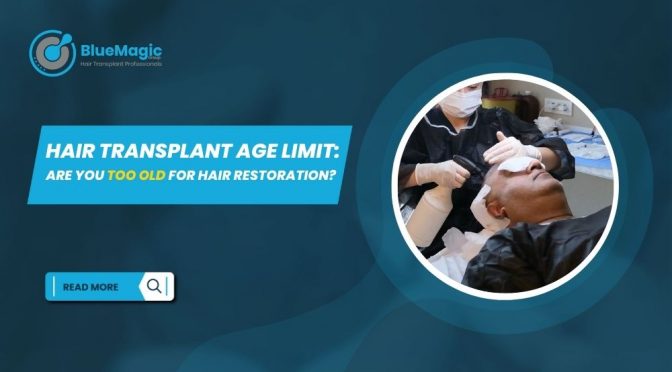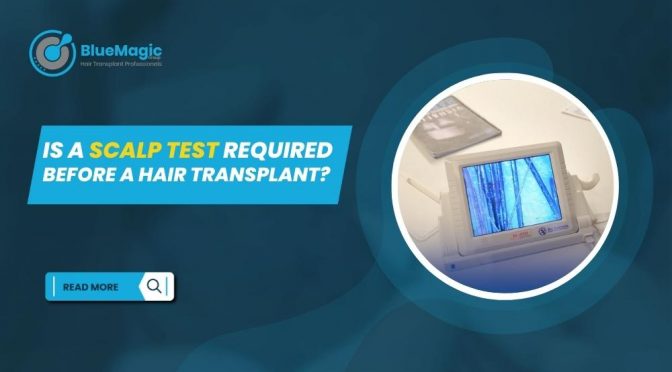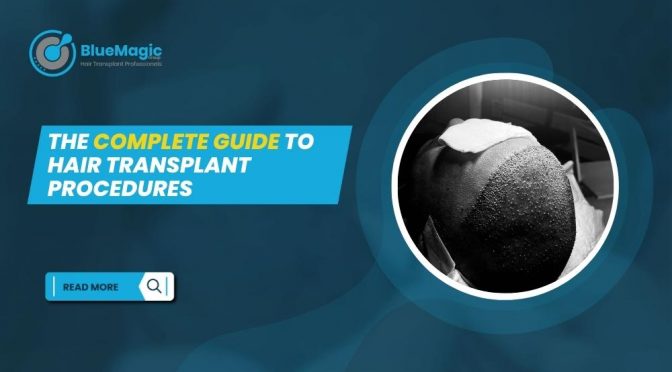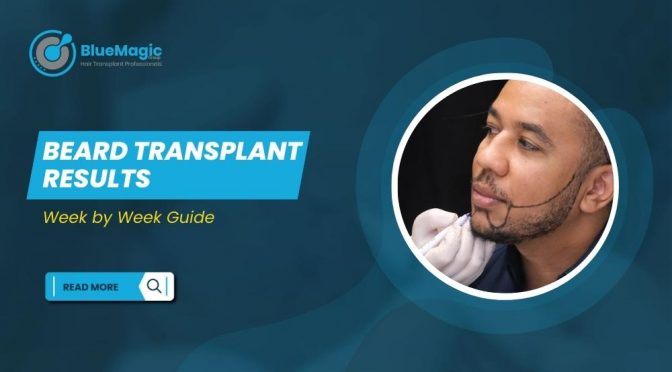Beard transplants are popular among men who want more attractive facial hair. This guide is designed to explain everything about the beard transplant results week by week, give hints on what is expected during the entire period of restoration and describe how people can get natural results. By understanding the surgery in-depth, patients are in a position to make wise choices that result in the best outcomes possible. Our hair transplant clinic, BlueMagic Group International, always offers valuable advice and proper care for all those who desire to improve their beard.
What is a beard transplant treatment and its purpose?
This type of procedure improves the density and appearance of one’s facial hair. The procedure involves getting hair follicles from a donor area (which is usually the scalp) and then transplanting them into the beard area. Particularly it is useful for men with uneven or thin facial hair and those who would like to have more defined full beards. Thus, creating an unnoticeable and natural beard that matches with one’s other hairs will enhance the overall image. The focus of this process is achieving a natural appearance.
How to Achieve Natural-Looking Results
A key objective in performing a beard transplant is to ensure a natural appearance. An unnatural or artificial look can undermine the entire aesthetic purpose of the procedure. To achieve this, the newly growing hairs must be meticulously placed to create a natural-looking result. This is accomplished through careful planning and execution, with the surgeon positioning each follicle to mimic the genuine beard growth pattern, resulting in a consistently realistic appearance. The density and angle of follicle placement are crucial for the seamless integration of new and existing beard hairs. At BlueMagic Group, our priority is to deliver results that enhance your natural features and meet your aesthetic goals.
The main steps involved in beard transplantation are as follows:
- Consultation and Planning: The journey starts with a thorough consultation where the surgeon examines the patient’s beard area to see if he is a good beard transplant candidate, discusses his goals, and comes up with tailor-made treatment plans. It entails reviewing the existing density of facial hair growth, the quality of the hair from the donor area, as well as the overall health status of the patient. This evaluation process provides enough information that will help in formulating a specific plan which meets the patient’s demands.
Primary Techniques for Beard Hair Transplant
- Hair Follicle Extraction: One of the most important stages in performing this operation is the removal of hair follicles from the donor site. There are two common methods used during extraction namely:(a) Follicular Unit Extraction (FUE): This involves getting one strand at a time by using special equipment developed for such reasons. Each strand will then be extracted cautiously before transplanting to another part like the beard region where regeneration works best. This method does not leave big scars on patients due to its minimally invasive nature thereby creating small imperceptible wounds.
(b) DHI Hair Transplant: DHI is performed using a pen-shaped tool that directly inserts hair follicles into the beard area thus eliminating the need for pre-prepared recipient sites which allows faster healing and more accurate results. DHI is popular because it’s pain-free, and causes less scarring.
When the follicles are prepared, they are placed with great care into the beard region. The correct placement and angling of each individual hair follicle is key to having a natural appearance. It can be understood from this that their arrangement replicates how hair grows naturally on the beard. This contributes to them looking like an authentic part of one face.
At BlueMagic Group, we utilize advanced techniques to ensure optimal implantation and alignment of these organs.
- Post-Operative Care: After surgery, patients receive detailed instructions on postoperative care. This includes washing the beard area, avoiding certain activities and taking prescribed medicines among others. Proper post-operative care promotes better healing outcomes and excellent results in general. Patients should avoid touching or scratching the transplanted area to prevent dislodgement of grafts; in addition, following an appropriate cleanliness routine will help to keep infection away.
Essential Beard Transplant Post-Operative Care
Wound Healing:
- Keep the Area Clear and Dry: Use a gentle cleanser given by your healthcare provider to clean the place of operation. Avoid use of hard soaps or scrubbing around it.
- Put on Medications as Directed: As directed, apply topical ointments or creams to help in healing and prevent infection. Follow the prescribed timetable and avoid putting in more than the required quantities.
Avoiding Irritations:
- Avoid Products That Irritate: Until you are allowed by your physician, do not apply makeup, lotions or other skin care products to the surgery site.
- Stay out of the Sun: Use sunscreen specified by your healthcare provider or wear a hat to protect the area from direct sunlight. Exposure to the sun can change pigmentation and slow healing down.
Activity Limitations:
- Cut Down on Physical Activity: Do not engage in heavy lifting, vigorous exercise or any strenuous activities within a recommended period. Doing these activities prematurely may lead to complications or affect outcomes.
- Do Not Bend Over or Lift Heavy Weights: In case you have been told so, then avoid bending over at the waistline while picking up objects with weighty loads that might cause some strain on wounds.
Proper Diet and Hydration:
- Maintain Balanced Feeding: For healing, you should eat a meal that is nutritious and rich in vitamins and minerals. During this period, recovery may be boosted by protein-rich foods as well as vitamins A and C.
- Always Stay Hydrated: For optimal body hydration, drink adequate water, which is an essential factor for your perfect healing process.
Drugs Administration:
- Follow Prescription Instructions: Make sure to take all prescribed drugs such as antibiotics exactly as directed including those for painkillers. So without any advice from the doctor on what dosage adjustments will entail etc.. you must not discontinue using them.
Side Effects Monitoring: Always be aware of any side effects of the medication taken into consideration when abnormalities happen immediately report it to your medical partner.
Avoiding Specific Behaviors:
- No Touching or Scratching: Avoid touching surgical sites by yourself because it can cause graft displacement or introduce bacteria there.
- Do Not Smoke and Drink Alcohol: Smoking and drinking alcohol should not be allowed since they interfere with the healing process leading to complications in most cases.
Follow-Up Appointments:
- Attend All Checkups: To verify your improvement, express worries about something if there are any concerns, and make changes if needed in your care plan to this reason, ensure that you visit your doctor for all follow-up appointments scheduled after surgery.
Sleep and Rest:
- Get Enough Sleep: Ensure you have enough rest and sleep so that recovery can be fastened. If necessary use pillows to elevate your head slightly decreasing swelling around eye sockets
Hygiene Practices:
- Use Fresh Towels and Pillowcases: Change towels and pillowcases often with clean ones so that chances of developing infections are minimized.
- Stay Away from Hot Showers: Over the next few days avoid hot showers or steam rooms since doing so could irritate your incision(s). Meanwhile prefer lukewarm water instead.
Bear Transplant Results Timeline: Week by Week
Understanding how long it takes for results from beard transplant procedures can help manage expectations properly as well as prepare for recovery time following an operation. A typical sequence of stages exists between surgery and when visible results start:
Time after surgery – What to expect
There may be redness and swelling after a beard transplant during the first week. This is normal and usually goes away slowly. For ease of management of these symptoms and to aid healing, it is important that patients abide by postoperative guidelines.
During this period, tiny crusts may form around the transplanted follicles. It’s natural for hair transplant to shed at this time; this shedding is a result of the hair growth cycle. Patients should take no notice of the shedding if it occurs because it will last a short while and is part of the overall healing process.
Here you will start witnessing the first beard transplant results. New hair starts growing as healing progresses. At first, it might seem like straggly weak hairs are coming back. The finalizing process of beard shaping takes time; thus, men have to be patient throughout this stage. Post-care instructions must be followed always so that strong growth can occur.
At this stage, transplanted hair thickens resulting in more well-defined beard growth patterns appearing. There might still be some thin areas but generally, there is an increase in overall development rate. To enhance any further progress on their facial hairs patients need to accomplish the steps they were given earlier on.
About three months after surgery, the beard starts looking denser and more uniform in appearance. Growth continues with thicker hairs which fill out incomplete appearances. The immature hairs should start filling up any blank spaces left from before.
During Months 6 – 12 people will witness its full glory indicating optimal density along with lengthening becoming noticeable as well as continued growth or thickening ultimately leading into fully developed bushy natural-looking chin whiskers by year-end when clients begin realizing the outcome of their operation instead.
Success Rates and Impacting Factors
Several factors contribute to the success of beard transplantation:
- Surgeon’s Skill: The expertise and experience of the surgeon play a critical role in achieving natural-looking results. A highly skilled surgeon will also implant hair follicles properly and at an angle which makes it look more real. Our team of experts at BlueMagic Group is dedicated to providing quality service that achieves exceptional results.
- Patient’s Health: General well-being together with adherence to post-operative care can influence the recovery process and the outcomes. Patients who follow instructions given during care can achieve better results especially if they are healthy in general. Before the surgery, you need to inform your doctor about any existing health problems.
- Technique Used: The technique used for implanting hair like FUE or DHI affects the outcome of transplantations. Each has its pros and cons, so it depends on individual peculiarities including your preference. For them to figure out which one suits your case best, our doctors from BlueMagic Group Clinic will consult you on every step until they come up with the appropriate approach plan.
- Individual Characteristics: Hair texture, skin type, and genetics can influence the results of a hair transplantation procedure. Potential candidates should take these factors into account before undergoing surgery, including skin type, hair type, and any family history of baldness or thinning hair. Consulting thoroughly with a surgeon will help patients understand all the associated risks, allowing for the development of personalized treatment protocols that meet their specific needs.
Conclusion
A beard transplant is a life-changing procedure for men who want to improve their facial hair and achieve a thicker, more authentic beard. To get the best results from the procedure, people have to understand it, set achievable goals and observe it afterwards. To make sure that things go well and your beards look good and confident, one needs to consult an experienced surgeon who will provide advice on how treatment should be approached.
For us at BlueMagic Group Clinic, we believe in extensive consultation as well as individual care so that customers can feel satisfied with what they are getting. Our team of experts will take you through all the steps of having a new beard implanted in you beginning with your very first appointment to treatments after surgery. We put our patient’s comfort first before anything else when doing this surgery so that it can satisfy them and at last produce positive results.
If you are considering getting your beard transplanted then there is a need to conduct elaborate inquiry about this matter, consult professionals and make informed decisions according to your objectives or expectations. It will require the right approach alongside professional support for one to undergo a beard transplant as it is no doubt uplifting self-confidence and long-lasting physical improvement.
What makes BlueMagic Group stand out?
Picking the most suitable facility for your beard transplantation process is what determines if you will get the desired outcomes or not. At BlueMagic Group Clinic we have:
- The Best Surgeons: Our team comprises highly trained surgeons who specialize in various hair restoration techniques including beard transplants. Our surgeons use modern approaches aimed at achieving perfect results as well as natural looks. They have been practicing FUE along with DHI for quite some time hence enabling us to customize each case.
- Personalized Attention: Every patient has different needs which we must address by coming up with tailor-made plans that work well for them. Starting from the first consultation preceding the operation until even aftercare we engage ourselves fully in delivering personalized assistance to you.
- Modern Facilities: The clinic that we are operating in has been designed with cutting-edge technology to ensure that the patients have a smooth sailing process. Our hygiene levels are highly maintained and a secure environment is created for patients’ well-being.
- Comprehensive Assistance: Our package includes preoperative consultations, detailed postoperative instructions, and checkups as part of our follow-up scheme. This is designed to ensure a smooth healing process and outstanding results. We are the only clinic in Turkey with a dedicated team of patient care coordinators who will monitor your recovery for up to 12 months after surgery.
- Commitment to Excellence: BlueMagic Group Clinic strives for excellence in all aspects of our practice. We aim to exceed patient expectations and are pioneers in high-quality beard transplant services, with patient satisfaction as our top priority.
- Cost-Effective Quality: Despite our premium services, we ensure that our beard transplant pricing remains competitive. At BlueMagic Group Clinic, you receive exceptional quality and results without compromising on cost-effectiveness.
Beard Transplants: Frequently Asked Questions
Q1: How long does a beard transplant procedure take?
A1: The length of a beard transplant procedure depends on the number of grafts needed and the technique. On average, this can last anywhere between 4 to 8 hours. Your surgeon will give you a better estimate based on your situation.
Q2: Is it painful to undergo a beard transplant?
A2: Most patients only feel slight pain during the surgery as local anaesthesia is applied to numb the treatment area. However, some discomfort or tenderness may occur after the operation, which normally subsides with recommended painkillers.
Q3: How soon can I get back to normal activities after my implant?
A3: After about two days, most people can go back to light activities following their beard transplants. It is however generally advised that exercising and other strenuous activities be avoided for at least fourteen days to allow full recovery. Specific directions shall be provided by your surgeon depending on how well you heal.
Q4: How long should I wait before seeing the final results of my facial hair transplant?
A4: While initial growth may become visible in weeks, it usually takes between six and twelve months for one to witness the final effects of beard grafting. Further density enhancement and aesthetic improvements are possible through maturation and growth stages in its hairs.
Q5: Will a Beard Transplant Produce Permanent Results?
A5: In fact, once performed correctly, beard transplantation offers permanent solutions. Additionally, the transplanted follicles are obtained from areas genetically programmed to grow hair for life; hence they do not go bald even in future if proper post-operative regimens are followed closely enough to ensure long-lasting results.
For more knowledge about this technique or to schedule a free beard transplant consultation meeting please complete the form here. BlueMagic Group Clinic is here to help you achieve your dream facial appearance, especially if you’re looking to grow luxurious-looking beards and enhance your overall look.



